See, I was going to originally title this "Apple's Secret Theme Tool!!", in an effort to clutch your e-eyeballs dramatically. (I've gotta get this here vortal to be more sticky!) Unfortunately, a public patent filing isn't exactly "secret". And this is all about one of the most interesting Apple patent filings I've seen lately.
Well, interesting to me, anyway. My job has been heavily user interface design-tastic these days, and I'm also personally (and perhaps unhealthily) obsessed with the concept of resolution independence. So when Macsimum News posts a story about a Apple patent regarding a resolution independent user interface, my nerd-senses start tingling faster than an morning shower with Dr. Bronners. (Except without the crazy-ass text.)
First, if you're super curious, download patent filing itself, courtesy USPTO. I've made it into a nice PDF for you:
Resawhosa Indewhatnow?
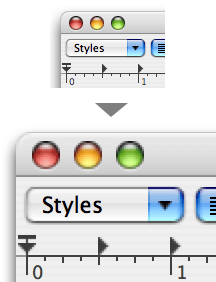
Scaling in 10.4 is chunky. Not for long?
Now, if you were to use today's Mac OS X on that display, everything would be really tiny, because a button can only be drawn at one, fixed size. More pixels, with fixed (72 DPI) controls, equals tiny town, i.e. Aqua Villechaize.
A long term solution is needed, one that all OS developers are looking at: a user interface that can scale at will. A resolution independent interface, even. Have an Apple High-DPI MegaCinema Display? No problem. Just scale the user interface to twice its regular size. Every single button, title bar, piece of text and scroll widget draws itself at a new size. The result is silky smooth — beautiful buttons, beautifully clickable, and beautifully high-resolution. That's the idea, anyway. It just needs to, you know, be programmed.
If you were to do this today in Mac OS X 10.4, the user interface would look pixelated (and you can do this using Quartz Debug) — graphics are just doubled to twice their size. That's because the Mac OS X UI is still rooted in Mac OS 8 days, defined by a series of resource files (!) and bitmaps. There's just no space in the crusty old format for "bigger sizes", let alone "flexible sizes".
Apple's Fascinating Plan
Now, if you were to ask me how to solve this problem, I would have said: "just create a bunch of graphics for each of the different DPI settings! Done!". So you have your 72 DPI button, and your 288 DPI button, etc. Multiple copies of everything. (In fact, this is largely what developers will have to do, in many areas.) And this is why I'm not an Apple rocket doctor.Here's the deal with this patent: Apple's approach seems is far more interesting, and ultimately more amazing. In essence, they're creating a user interface that's completely programmatically defined. I.e., not an exported series of graphic resources, but a series of instructions that define how the graphics should be drawn, from the ground up, just like you might create a graphic in Photoshop, all the way from "Create New Document" to "Add Drop Shadow". That means that talented Apple artists can sit down with a special internal tool — not Illustrator, not Photoshop — and craft the user interface of their dreams. And when it's time to scale it, meanmo! It just, theoretically, works, because each element is made of a series of layered, defined steps. New, higher resolution versions are instantly rendered based on the original (XML?) specification. Essentially, Apple has invented a scaleable hybrid vector/bitmap user interface that is created and edited by their own full-featured graphics tool. Phew! This is, as far as I know, a total first in the industry.
And did I mention this patent names Mark Zimmer as its inventor? You know, the guy who freakin' created Painter? Yow.
The Theme Tool
Far more interesting to me than the words in the patent were the pictures in the patent. Of course, we all know by now that Steve Jobs isn't too keen on allowing Mac OS X to switch themes, for a lot of reasons I can understand.That makes these pictures all the more interesting — these crappy screenshots of Apple's internal theme creation tool, presumably being used right now to create the next great UI. Put simply, this may be the first and last time you'll ever see this thing.
Check it out — full-featured is an understatement. (Download the .pdf for more.)
So, this is some intense technology.
And if I were a betting man, I'd say we're going to see the fruits of this labor very, very shortly. It looks like Apple now has the tools to create a user interface for the future — all that's left is to see what the future actually looks like.



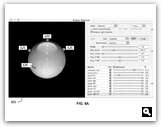
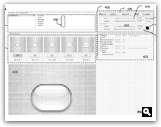
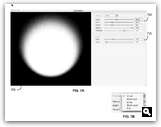
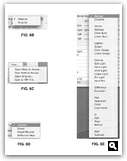
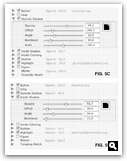
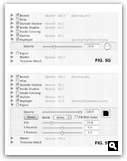
42 Comments:
I wonder if Apple has engineered a solution sufficient to beat this limitation. From the PDF:
"...while other attribute values are specified for two or more resolutions. In general, those attributes associated with the physical location of geometry of an object may be associated with a plurality of values - one value for each specified resolution."
Also, jello wrestling FTW! Post-wrestling clean-up with Dr. Bronner's. It's a win-win!b
I think that's at least a tiny bit misleading. The average person might think we're all still using ResEdit and resource forks. In fact, it's possible for applications to draw correctly at higher resolutions today (at least in the places not defined by the OS), but it could be made a lot easier.
This tool looks really interesting, though.
Sounds very similar to Flash or SVG.... Actually, I wonder if this tool does end up outputting SVG since that's open source.
And for developers looking at supporting resolution independence and thinking, should I care? the answer is clearly yes.
//k
While I'm not particularly impressed with scalable images (finally) being applied to the entire desktop environment, it is nice to see a major vendor finally realize that 72 DPI isn't for everyone.
Having been running at 120-something DPI for the last few years (14-15" screen at 1400x1050), it annoys me to no end how OS and monitor vendors don't seem to care that DPI is an absolute, object unit of measurement in Euclidean space.
It could be used for other things, too, of course...
I'm just gonna throw this out there, because we all know that Steve has a flair for the dramatic.
MacWorld might be very consumer-oriented, but if Steve has anything - anything at all - to say about resolution independence tomorrow... Couldn't that explain the extreme proliferation of Space Odyssey -esque Apple-logo sinage?
I could very well imagine Steve saying something along the lines of "Just to show you how incredibly great our res-independence effort has been, know that every single Apple/Obelix sign you've seen, from website to 100 foot posters, were created using a single resource file."
I know, it won't happen. But wouldn't it be cool if it did? What? No show of hands?
Apple may have developed a way to use it as the main UI for an OS, but the credit goes to Microsoft (shock, horror) for implementing this long before Apple. Take a look at XAML and WPF (Windows Presentation Foundation) sometime, as well as the "Expression" design tool for XAML.
and to add on to what peter said: http://en.wikipedia.org/wiki/Microsoft_Expression_Blend has a bit of info on the topic.
Or at the very least will force the issue of using only relative units...
And Richard Stallman will think you *really* deserve punishment for that. Seriously - I was just reading one of his articles that someone had linked at Slashdot and he says:
"people who develop proprietary software that's attractive deserve a punishment."
http://fsfeurope.org/documents/rms-fs-2006-03-09.en.html
Well, Panic's software is some of the most attractive (in a number of senses) software out there. So Panic would obviously deserve a *lot* of punishment in Stallman's eyes. :-)
At first glance I don't see much difference between vector (SVG/PDF etc) and the procedural rendering based here. The one advantage might be that this hooks directly into Quartz, whereas SVG etc aren't based on those kinds of GPU-based filters.
Fig 4 does show some tweaking for the various UI sizes, which is crucial, even with 160+ DPI displays and fairly small icons.
The "recipes" look like a great way to design UI though. I'm all for it!
Could I borrow some trash from someone? I need to fuel up my Mr Fusion so I can get back to 1985 to file a patent on this.
Since people generally don't change their screen resolution all the time, I bet the system would use bitmap caching of some sort -- i.e. create the proper-resolution bitmaps once and not re-render them every time (or has somebody already said this?).
The idea of doing this for user interface is not new either (XAML being one example of this...).
What's supposedly new according to the patent is the method associating numerical values (essentially placement information) to a 'material map' which as I understand, is just a data structure containing the controls of a window... and a method to use this information to layout the said window.
Personally, I'm happy to see that they are actually working on something for resolution independence but I wouldn't call anything they are doing earth shattering.
When I first started using OS X I was amazed you cannot simply wind up the screen font size system-wide like you can on Linux. I've been told this is because UIs on OS X are not defined using containment based layout, which I find hard to believe but would indeed explain this. Apple aren't really doing much new here, they're just catching up with what was state of the art 2 years ago on Linux.
http://haiku-os.org/node/280
watch. you can use those money to invest in other industry which will return you good
profit.
watches ebayare made by the rating 1:1 according
to the original watches, and you can't distinguish the original and the fake watches when
you look at the surface of the watches.
batteries
I should add that in the next version of Windows (after 7), all the UI might be in xaml as an announcement stated that icons would be.
The latest fashionable wigs online store, global free shipping service. :
Football Fans Wigs&Tools
Football Fans Wigs
Football Fans Tools
Human Hair Wigs
Straight Hair Wigs
Curly Hair Wigs
Afros
Men's Wigs
Children's wigs
Hair Pieces
Hair Extensions
Costume Wigs
Halloween Wigs
Party Wigs
Wigs Accessories
sohpetchat siteleriyonja
sohbetnetlog
chat sitelerimirc indir
dini sohbetkizlarla sohbetsohbet et
sohbet et
muhabbetsohbet
cinsel sohbetchat
sohbet odalari
fx15
lw6090
rx1
biber hapi
biber hapi
iyinet frmtr trkygnclr webmaster seo yarışmasi
flip chatchat roulettechat roulet
Post a Comment